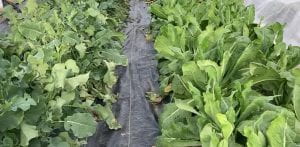Recent New York autumns have been humid, wet, and optimal for high plant disease pressure. This increases the challenge level to produce marketable fall brassicas like broccoli and cauliflower, especially for organic operations. Are you supporting your farm’s spray regime by incorporating cultural practices to help reduce disease?
- Start with the basics. Rotate brassica crops to break disease cycles (don’t forget to account for brassica cover crops!). Manage soil fertility for healthy plants and start with clean seed and seedlings. Make sure to use reputable seed and transplant sources.
- Avoid planting stressed or damaged seedlings. Weak plants or root-bound seedlings are more susceptible to disease. Consider adding more succession plantings of fall brassicas into your greenhouse plan, so that you have backup seedlings you can substitute for overgrown transplants in case wet weather forces planting delays.
- Practice good sanitation. Don’t leave cull piles near your fields. Make time to incorporate old plantings quickly so there are less disease vector hosting plants hiding around the farm.
- To take sanitation to the next level, assess harvest and field workflows. Are you picking from a damp field with heavy disease pressure in the morning before weeding (and potentially transmitting disease) in a new planting that afternoon? Work from healthier to less healthy fields and avoid heavy traffic in wet plants when possible.
- Choose disease resistant varieties, and search for varieties that match your site’s conditions. Faster maturing varieties can sometimes outpace disease issues and yield better.
- For growers with flexible customer bases like direct markets or CSA, consider training your customers to accept alternate, more disease hardy crops like sprouting broccoli and cauliflower rather than traditional varieties. These non-heading plants produce marketable yields even when lightly infected.
- Assess your bed spacing. Less dense plantings allow better airflow and increase foliage drying speed. If you plant three dense rows per bed and see recurrent disease, try two rows per bed. Widening in-row plant spacing by two to four inches can likewise reduce the overlapping “drip line” effect of leaves dropping water (and potential pathogens) onto neighboring plants’ heads.
- If flea beetles are a major disease vector on your farm, consider incorporating row covers or netting to reduce disease. If you reuse row covers, label and rotate them between crops so that you aren’t dragging old fabric loaded with an earlier planting’s Alternaria onto a freshly planted plot of healthy crops.
- On the flip side, minimizing row cover use is a better strategy if your site experiences too much or too little airflow. In wind, covers abrade plants and open wounds for pathogen entry. On poorly ventilated or warm sites, covers trap heat and humidity, reduce airflow, and increase disease activity.
- For a high cost, but statistically significant disease reduction strategy, use mulch or ground cover. Plastic, landscape fabric, and straw mulches all reduce brassica disease loads in trials and may be an economically viable practice for smaller operations.
